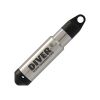Van Essen Baro-Diver Barometric Pressure Logger
Features
- Compact size: 22mm diameter x 110mm length
- Stores 72,000 records of time stamp, pressure and temperature with backup
- Continuous and fixed length memory (linear sample method)
- Free ground shipping
- Expedited repair and warranty service
- Lifetime technical support
- More
Overview
The Van Essen Baro-Diver ensures accurate capture of changes in atmospheric pressure. Conveniently priced and easy to adjust, one Baro-Diver covers a radius of up to 15 km, depending on the topography. The Baro-Diver can also be used for measuring shallow water levels up to approximately 1.5 meters.
Memory
The Baro-Diver has an internal memory capable of storing 72,000 measurements per parameter with new backup memory feature. For each measurement, the Van Essen Baro-Diver simultaneously registers barometric pressure, air temperature, date and time.
Applications
- Monitor potable water recharge areas for water supply
- Monitor tailing ponds, dewatering activities and water supply levels of mines
- General site investigations for construction
- Contaminant plume monitoring on spill sites, remediation sites, chemical storage facilities, landfill sites and hazardous waste storage sites
In The News
Van Essen Diver-Link Cellular Telemetry System with Diver-Hub
The Van Essen Diver-Link Cellular Telemetry System enables professionals to monitor water level, conductivity and temperature readings from their home or office. The near real-time data allows scientists, managers, and other environmental professionals to monitor flood events, well depths and groundwater levels. Long-term monitoring allows users to develop trends on ever-changing climate conditions. The Van Essen Divers ( CTD-Diver, Cera-Diver, TD-Diver and Mirco-Diver) work well for monitoring water supply, tailing ponds, dewatering, contaminant plumes and hazardous waste storage sites . The Diver-Link allows users to monitor groundwater via the Diver-Hub Web Portal for real-time management of site data, equipment and water levels.
Read MoreSafeguarding Communities with Real-Time Flood Monitoring in the City of Hazelwood
The City of Hazelwood is a suburb in St. Louis County, Missouri, home to around 25,500 people. Recently, the community has suffered increased flash flooding following severe storms, prompting the need for the installation of a flood monitoring system. In 2022, a NexSens X2 data logger was installed to monitor water level and rainfall in real-time, with the aim of reducing the loss of life and property as a result of extreme weather events. [caption id="attachment_39411" align="alignnone" width="940"] The latest flood event at Coldwater Creek, where the water level rose by 14 feet, exceeding the height of the X2 by three feet. The sensor can be seen behind the wall that usually contains the Creek.
Read MoreSave our Bogs! Culture, Conservation and Climate Action in Ireland’s Peatlands
Characterized by long-term accumulation under waterlogged conditions, peatlands exist on every continent and account for 3-4% of the global land surface . Small but mighty, these often overlooked wetland environments are estimated to hold as much as one-third of the world's organic carbon in their soil—twice the amount found in the entirety of the Earth's forest biomass. While healthy peatlands can trap and store carbon, regulate water, and provide important habitats for rare species, human alteration has disturbed peatland carbon and nitrogen cycles on a global scale. Approximately 12% of the world’s peatlands have been drained and degraded through conversion for agriculture, forestry, infrastructure development, and other uses.
Read More





































